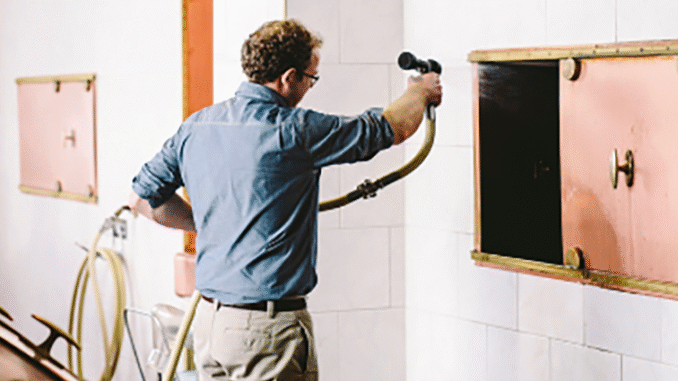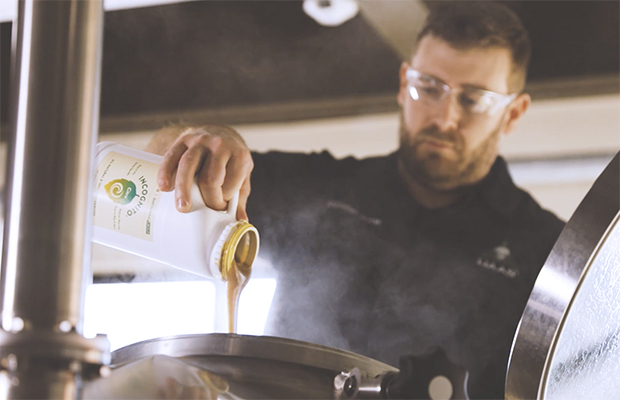
Maximizing productivity is critical in any brewing operation, no matter the size, to ensure that time and resources are utilized effectively. Effective cleaning and sanitizing are arguably the brewer’s most important tasks, helping ensure consistency and quality from brew to brew. Clean-In-Place (CIP) wash procedures for vessels on the cellar-side of the brewery commonly employ a hot-water sanitizing step as part of the CIP process to eliminate or reduce chemical use. This method is often perceived as a way to reduce operational costs while protecting the beer quality. However, it is important to assess the total impact on operational costs by understanding the value of time and energy savings associated with the hot-water sanitizing step.
Cold Sanitation
A hot water sanitizing step requires energy, time, and a cool-down rinse step that can largely be saved by employing a cold-sanitizing process for the CIP of the cellar vessels. In the cold sanitizing process, temperate water is circulated through the CIP circuit with the addition of an EPA (Environmental Protection Agency) approved sanitizer. Mixed-peracid sanitizers (e.g. peroxyacetic acid [PAA], peroxyoctanoic acid [POOA], etc.) offer benefits beyond traditional peracetic acids in the brewing operation that make them a great choice for use in a cold-sanitizing process.
Benefits of using a peracid or mixed-peracid sanitizer in place of hot water as a sanitizer include:
- Energy reduction — Sanitize using cold (temperate) water compared to hot water
- Faster CIP — Minimal or no heat time required prior to the sanitize step.
- No cool-down step — Lower temperatures mean no need to wait until equipment cools prior to use, saving you time in your CIP.
- No post-rinse required — By eliminating a final rinse step you can save time while also reducing the risk of a contaminated water source following the sanitize step.
- Mineral solubility –—Low-pH mixed-peracids can reduce scale build-up post-sanitizing and lead to less frequent acid washes. These can also help address common pH-sensitive brewery soils such as beer-stone (Calcium Oxalate).
In the case of Synergex™ Sanitizer & Disinfectant, this mixed-peracid blend incorporates a mineral acid which lowers the overall pH of the use solution and improves mineral solubility. This can be beneficial in reducing the need for separate acid washing steps in your wash schedule.

In addition to the operational benefits, the peracid or mixed-peracid cold-sanitizing process is effective at controlling microorganisms that could impact beer, while also not posing a risk to the beer flavor profile. The ability to use a no-rinse sanitizer mitigates the risk and impact of poor rinse water quality, helping the brewer avoid any negative impact to the final product.
Benefits of implementing a cold-wash in your brewery operation
In addition to their sanitizing properties, certain mixed-peracid sanitizers carry benefits as a hard surface cleaner in CIP applications and can be used to further optimize the cellar side of your brewery. Although referred to as a “cold-wash”, this refers to the ability of these mixed-peracid sanitizers, such as Synergex, to clean tanks, BBTs, and fillers at ambient temperatures. In a cold-wash application, the mixed-peracid sanitizer cleans the vessel using a shortened CIP wash.
Benefits of this process include:
- Simplified CIP Process — Single-step cleaning process eliminates the need for a separate acid wash rinse step.
- Energy & Water Reduction — The shorter CIP process requires less rinse water and reduces the total amount required to be heated.
- Reduced Chemical Concentration — In many cases, the total concentration of the chemistry required for cleaning is decreased, leading to less acid in the effluent stream.
- Reduced Venting — For vessels using an alkaline wash program with a CO2 venting step a mixed-peracid product can allow for washing under CO2 conditions, saving CO2 consumption and time.
- Flavor Carryover — Leverage as a hard surface cleaner to eliminate flavor carryover when changing tanks between various products. This can shorten your normal CIP program required for changeovers. This is often most impactful when switching between products beyond beer, such as flavored seltzers.
When considering the use of a cold-wash using a mixed-peracid, it is important to consider your specific equipment, and the micro-risk associated with your product. Additionally, not all mixed-peracid sanitizers carry this specific use application. It is always important to refer to your product’s EPA-approved label for use directions as a hard surface cleaner and use them within the intended application.
Considering the use of a mixed-peracid in your brewery operations could help you reduce your brewery’s total water and energy consumption as well as save you time and money in your CIP process.






Be the first to comment